Annual report 2004 - Compagnia di San Paolo
Annual report 2004 - Compagnia di San Paolo
Annual report 2004 - Compagnia di San Paolo
You also want an ePaper? Increase the reach of your titles
YUMPU automatically turns print PDFs into web optimized ePapers that Google loves.
Programmes<br />
Turin’s Museum Programme<br />
Turin’s Museum Programme<br />
Programmes play a central role in the <strong>Compagnia</strong>’s activity framework. The <strong>Compagnia</strong>’s<br />
guidelines for establishing procedures and criteria to pursue its institutional objectives, define<br />
programmes as a “coor<strong>di</strong>nated and integrated approach aimed at one or more objectives consistent<br />
with the <strong>Compagnia</strong> aims, developing a cross-sector approach when required. Lasting several<br />
years, these programmes include integrating <strong>di</strong>rectly managed initiatives (inclu<strong>di</strong>ng promoting or<br />
participating in instrumental organisations, legal persons or consortia, etc), with support to projects<br />
and institutional support to external organisations’ activities”.<br />
This provided the theoretical background for launching the Programme to develop a Museum District<br />
in Turin’s city centre. Established at the end of 2000, the Programme is the <strong>Compagnia</strong>’s chief tool in<br />
fostering the process of urban, cultural, economic and social transformation that the city of Turin set<br />
out years ago in order to regain its status as arts capital. In this context, the notion of “museum<br />
<strong>di</strong>strict” embraces the idea of a coor<strong>di</strong>nated set of initiatives and relevant agreement between<br />
everyone involved in the transformation process of the city area identified as “zona <strong>di</strong> comando” (the<br />
District of Savoy Government). It is a historic and artistic site deserving to be incorporated into a<br />
whole and adequately enhanced museum system.<br />
The start up phase was centred around setting up a “museums development plan”, which aimed at<br />
both determining criteria and priorities, as well as establishing a framework of shared values and<br />
commitments both locally and nationally.<br />
The programme is organised into six main areas, inclu<strong>di</strong>ng some well defined specific<br />
characteristics. It aims at emphasising each monument’s historic importance through real recovery<br />
action as well as stressing their outstan<strong>di</strong>ng features and <strong>di</strong>strict-relevant character. Management<br />
tools and common standards for museums will be used capable of keeping up with innovation and<br />
meeting the needs voiced by today’s society.<br />
The six areas are respectively:<br />
- the area of the Roman Gates (Porte Palatine), the Museo <strong>di</strong> Antichità and archaeological park with<br />
itineraries of the Roman past;<br />
- Palazzo Reale (the Royal Palace) and the Royal Gardens, Palazzo Chiablese and “Manica Nuova”<br />
(the new wing), the future home of the Galleria Sabauda (Savoy Art Gallery);<br />
- Cavallerizza Reale (the Royal Ri<strong>di</strong>ng School): new opportunities for exposition areas, which could<br />
be integrated with the Royal Palace;<br />
- The via Po and piazza Vittorio Veneto area, in collaboration with the National Cinema Museum pole;<br />
- Palazzo dell’Accademia delle Scienze with the atmospheres and culture of Ancient Egypt- the<br />
Egyptian Museum being hosted in the Palace;<br />
- Palazzo Carignano with itineraries of the Italian Risorgimento and Guarini’s baroque architecture.<br />
75<br />
Taking into consideration the complexity and considerable financial commitment entailed by the<br />
Programme between 2000-<strong>2004</strong>, the <strong>Compagnia</strong> has set aside over 46 million euros to create an<br />
endowment fund, using over 86% of resources currently allocated for specific projects.<br />
During the year, in ad<strong>di</strong>tion to supporting the rehabilitation and enhancement of Turin’s prestigious<br />
Accademia delle Scienze historic premises, major efforts have also been put into instituting the<br />
Fondazione Museo delle Antichità Egizie (Egyptian Museum Foundation). It was therefore able to



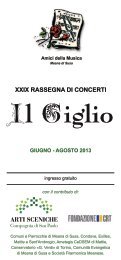
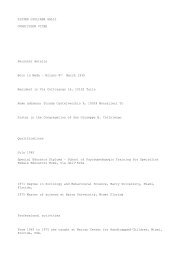
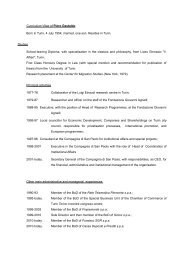
![ArchivioStorico 178 [PDF] - Compagnia di San Paolo](https://img.yumpu.com/47667361/1/185x260/archiviostorico-178-pdf-compagnia-di-san-paolo.jpg?quality=85)

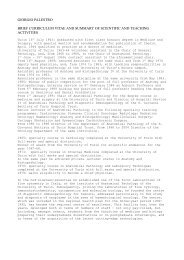
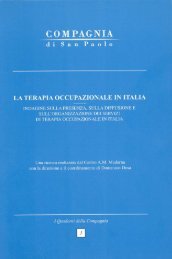
![brochure spazio 768 [PDF] - Compagnia di San Paolo](https://img.yumpu.com/36141511/1/190x255/brochure-spazio-768-pdf-compagnia-di-san-paolo.jpg?quality=85)
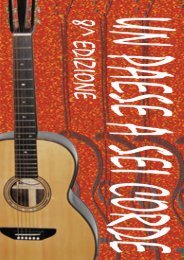
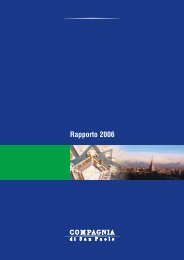
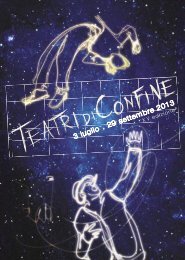

![Rapporto annuale 2008 [PDF] - Compagnia di San Paolo](https://img.yumpu.com/30320485/1/184x260/rapporto-annuale-2008-pdf-compagnia-di-san-paolo.jpg?quality=85)